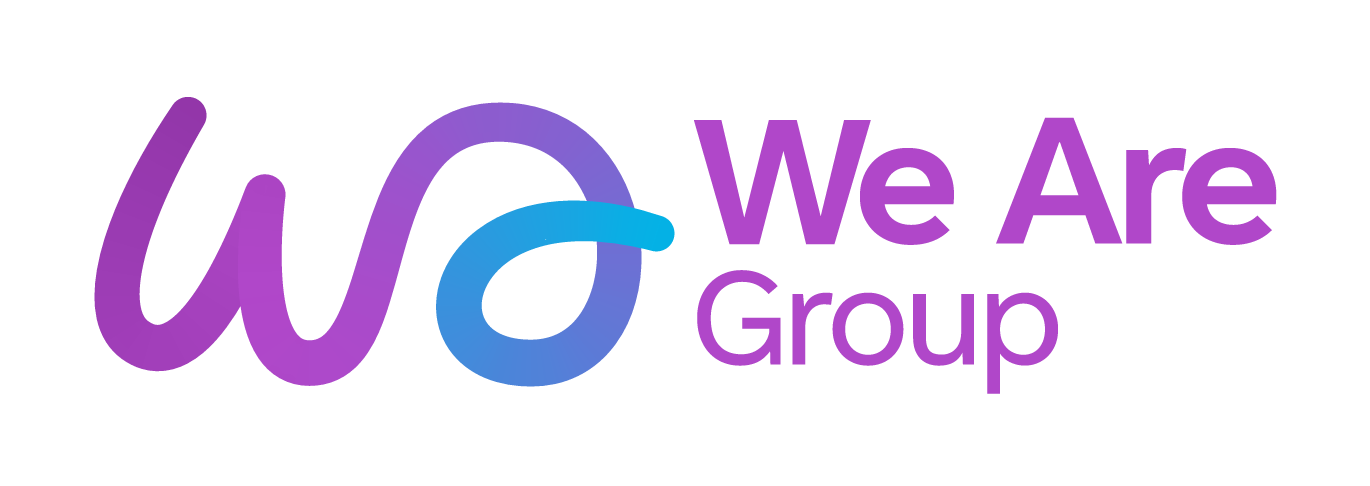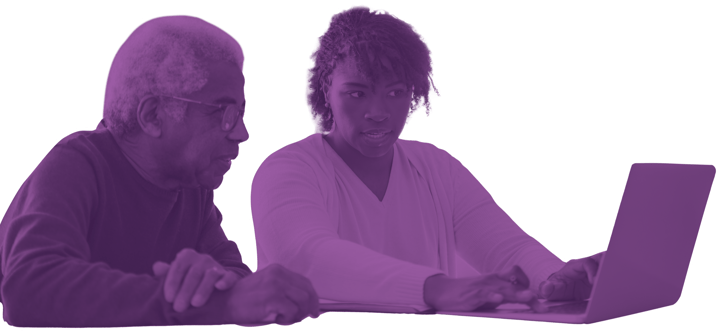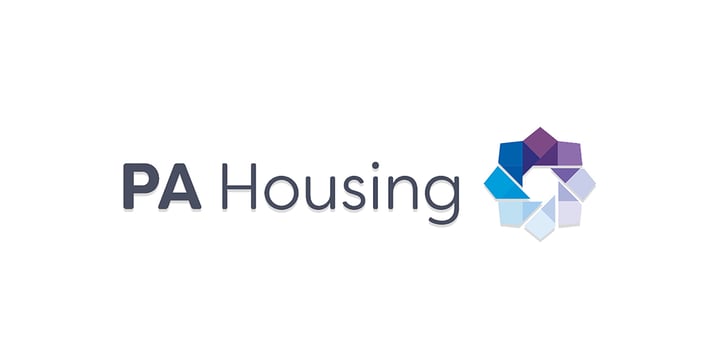I started the business from my bedroom with my Dad 10 years ago after being inspired by Baroness Martha Lane Fox in her Race to get everyone online by the end of the 2012 London Olympics.
I am a Tech Talent signatory, a Digital Poverty Alliance Community board member, and as of this week a Top 10 digital leader (looking forward to Thursday night’s ceremony Robin!) I’m really proud of what our company has achieved: we are backed by some of Europe's top impact investors and truly believe that to be significant and do good in the world, you first need to be successful.
We now help tens of thousands of people a year to:
- get online and stay online
- access essential government online services such as visas and justice services
- manage money and debts
- find and get new jobs
- Phone support
- Remote video trainers/advisors
- In-home 1:1
- Local centre bookings nationwide.
We help national and local government, housing associations and corporates, to support their customers to improve their lives, survive and thrive – and we do this through a unique way of running community investment programmes. More on that later.
What I want to talk about today is reinventing how we solve digital exclusion and welfare problems in general. We are investing in a NEW way to help alleviate these issues, such as the impact of the cost-of-living crisis and ending digital poverty for the millions of people across the UK in need.
And I’d like to start by asking a few difficult questions of us all:
- Why haven’t we solved this already?
- Do we need to approach this in a new way?
A decade ago, when I started We Are Digital, I had newspaper clippings on my wall of digital exclusion statistics. Whilst we know that in those last 10 years, thousands of amazing projects, big and small, across the UK, have helped a huge amount of people, there’s a part of me which thinks: the statistics never seem to change.
Why are there still 1.7M households totally offline, where one in 5 children did not have access to an appropriate device during the pandemic and where 11 million people lack the digital skills needed for everyday life, a statistic that I’m sure 10 years ago stood at 10 million!!
Ten years on we are left trying to end digital poverty and now in the face of the cost-of-living crisis things seem to be getting worse not better: 1/5 people and almost 1 in 3 children in our country are now living in poverty and over half of the UK is eligible for universal credit.
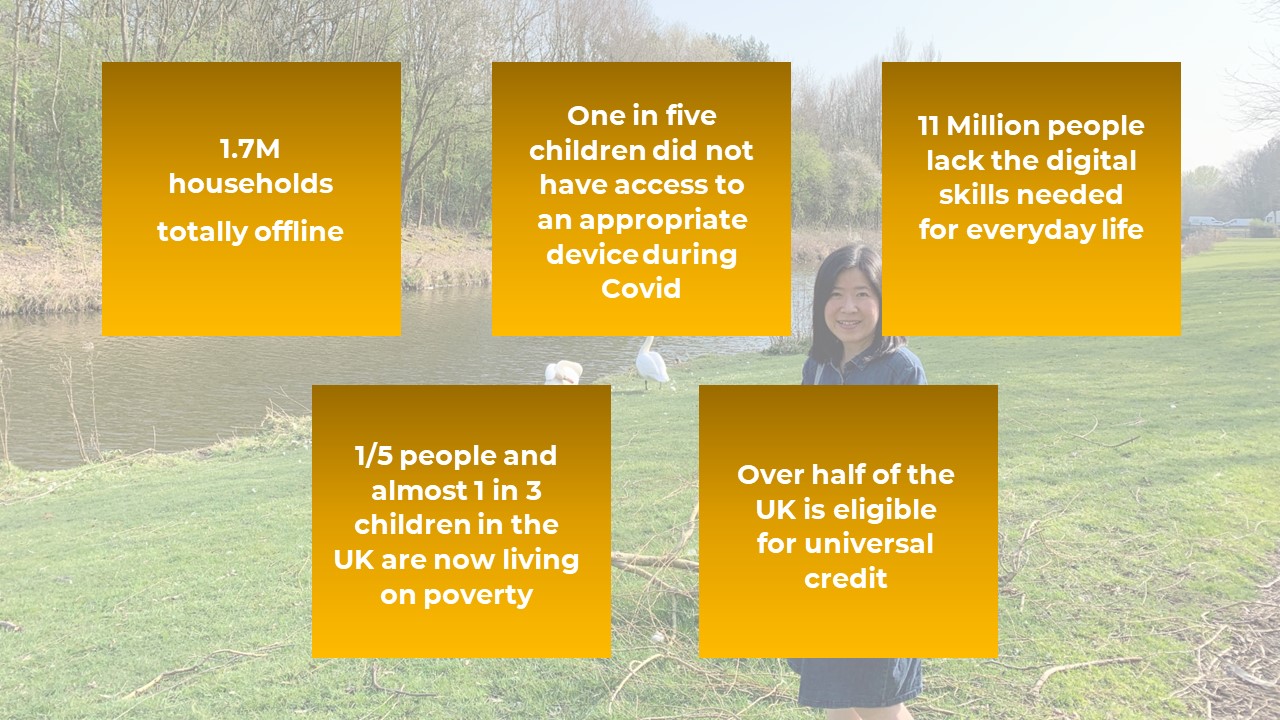
But here we all are in 2022, we didn’t do it yet, not by that 2012 Olympics when I first started, or by the next Olympics after that, or the one after that…….and yet …..I do think we can do it – but….to do it I think needs a little reset. A different way of thinking. A new model.
And the main thing I want to say today is….we don’t think it’s a model that is similar to what’s been done before. We can’t repeat the same ideas.
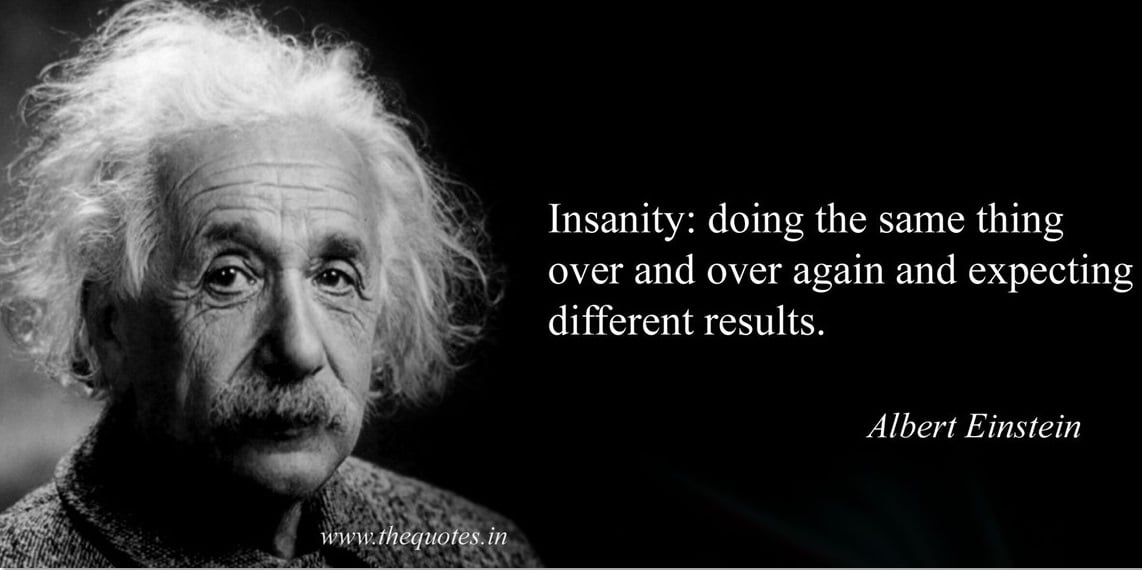
So what are we going to do?
Well many of us here at this virtual conference today will have hugely benefitted from the digital transformation we have experienced over the last ten years.
It’s ironic that I say this as I speak to you all and we don’t have to be in the same room anymore.
You are all over the country and some of you may be attending this event from the comfort of your sofa or from a coffee shop.
Not only has digital transformation improved the way we work, but we have most likely seen improvements in the way we live our lives too.
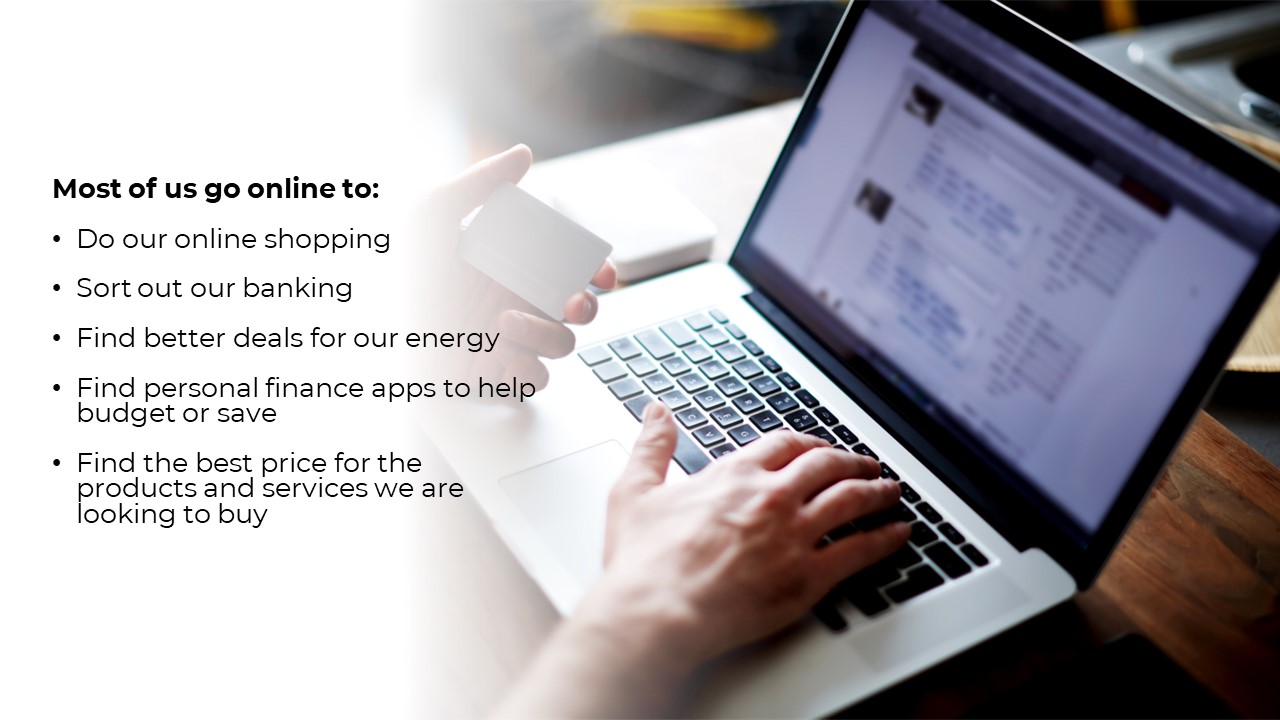
But……let’s just be honest for a second. You’ve heard this all before haven’t you? I know I have. I’ve heard these statistics before. I’ve heard the use cases before. I now think I’ve been to every digital inclusion conference that exists – and probably up until this point in my talk, everything I’ve just said – you’ve heard it before too. You know about the exclusion, the issues, the benefits of getting online, the statistics.
And you also know that while there is so much good being done to end digital poverty and so many good projects out there, it’s simply not enough.
And today we want to put forward some slightly newer, contrarian views, for discussion.
I firmly believe that the industry needs a bit of a shake-up. In talking to our key industry partners, like our centre network, our trainers, and organisations like Digital Unite, they too believe we need a different way. Normally, when I read strategy papers online, the requests coming out of them are about wanting more funding or more delivery. Whilst of course those two requests are never a bad thing, I’m here today to present a slightly different view: I think we need a new delivery method. A new model. A new way of doing things. In short: we need to stop and rethink.
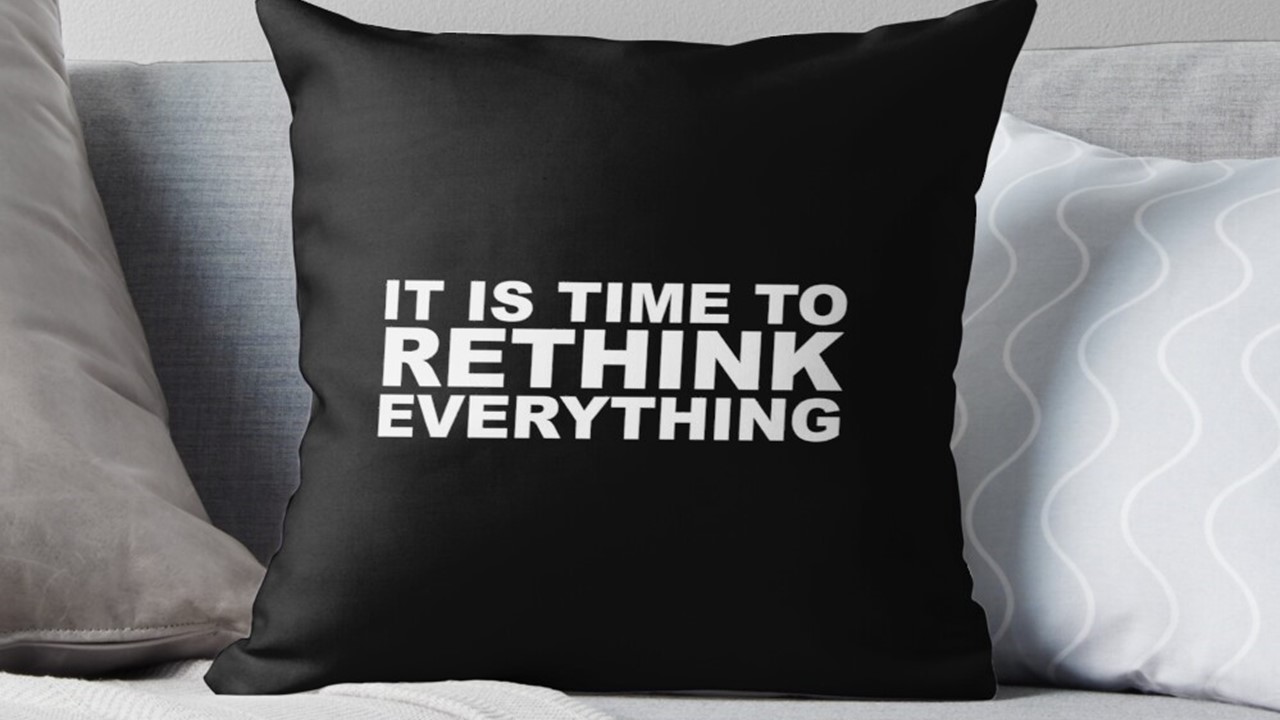
I don’t know if this is controversial or not, but I don’t actually think we need more delivery capacity.
In the UK 400 new charities start per MONTH. Just think about that for a minute. 400 per MONTH. There are 180,000 charities overall in the UK. In the advice sector alone, places offering money and skills support and advice, there are 10,000 independent advice centres alone in that sector (and that’s just the independents!)
In our own network we have many thousands of amazing centres doing great work already. And if we wanted to – we could have a lot more- we actually think the number of centres we could access, all told, in the UK for our contracted projects – is about 24,000 if we needed them. The library has 4000 centres alone. Citizens Advice have another 400. Age UK have hundreds. The Post Office has 11,000 centre locations. But the misnomer is that no-one really owns these – they are owned, in the most part, by individual entities, or the local authority. They are simply there, available for doing good.
And that’s just the centres! What about the call centres doing a great job on this (WAD run an impact helpline for many clients including Lloyds Bank), and what about the trainers? (WAD run a trainer network too) – and then the volunteers and the Digital Champions, through organisations like Digital Unite, who have thousands of champions doing work up and down the UK. Or the new tech-for-good startups – already helping those in need. I must meet a new one every single week.
And this is then just the skills side! But equally when you look at the kit and equipment offers and loan schemes, or the amazing sim-giveaways and Databanks now from the likes of Vodafone - everywhere you look it is there.
The help is already there. It is DEFINITELY there. It is, in fact, everywhere. I for one don’t get the sense when I come away from conferences like this, that we need more trainers, or we need another centre. They are most certainly all there.
But….we think this needs to be organised differently. We think the MODEL of how the sector actually works, and HOW that support is delivered, is what should be discussed, not the WHAT of the support itself.
We think this newer model is one that is:
- based on what human beings do, what they want and what they need.
- that brings all services under one roof
- connects existing services together
- helps people wherever they need it,
- is powered by a tech-based delivery platform
- and which doesn’t forget the value of human intervention
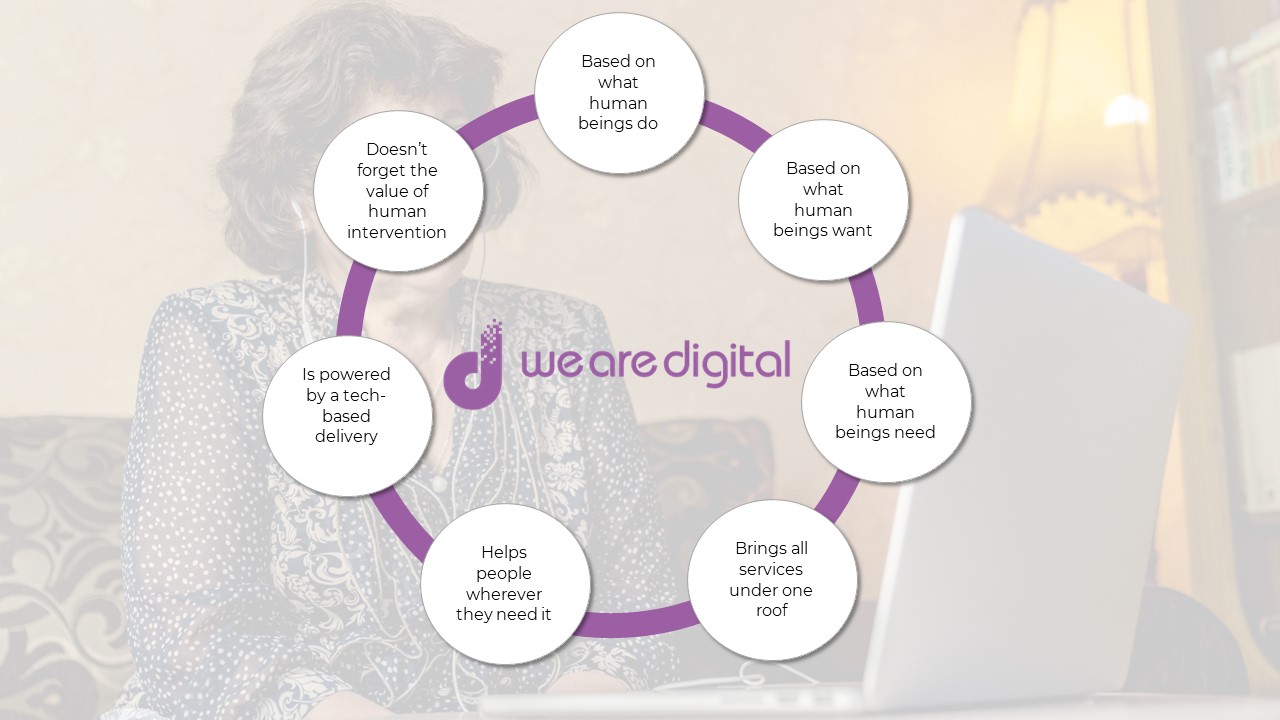
A one-stop-shop that for the first time could organise the sector under one roof, and bring an end to digital and financial poverty for good.
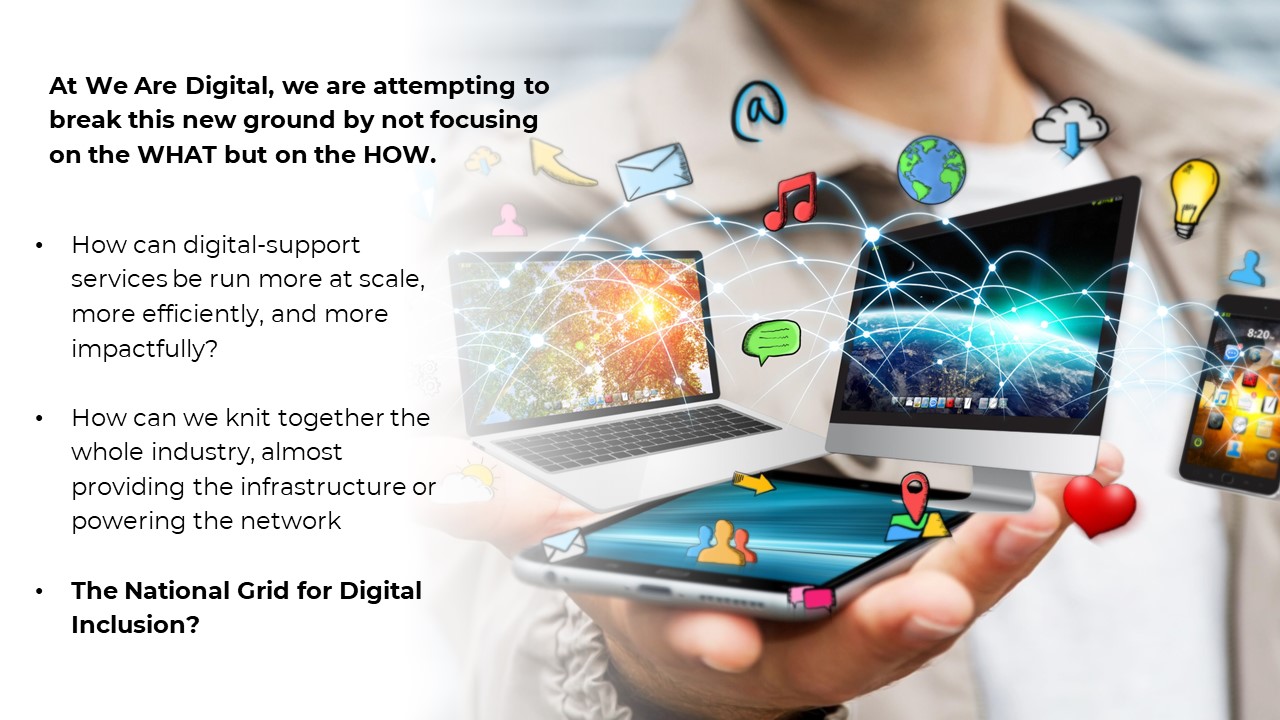
It is in this way that at We Are Digital, we are attempting to break new ground by not focusing on the WHAT but on the HOW. The what / the output, could actually be anything (digital, debt, energy, food, health support).
But How can digital-support services be run more at scale, more efficiently and more impactfully?
How can we knit together the whole industry, almost providing the infrastructure or powering the network as it were – a bit like the National Grid for Digital Inclusion?
It’s such a simple premise, but the penny dropped for me a year or so ago when I finished up at a conference. I realised that I think I’ve met by now most of the operators in this space: from government to the big corporates, to the small social enterprises.
And at these conferences, the buzz is phenomenal and like today we all get excited by what everyone is up to. But then the conference, or the meeting, or the phone call, ends – and I realised actually: everyone goes back to their own location, to their own project, to their own funding, and continues on in their way, in their own patch. And there’s nothing wrong in that – but it never felt like anything got connected. Rarely did I feel that those providers knew the others existed, and were able to link to them in a tangible way. It’s as if there were 10,000 amazing projects happening all at once, but in silos.
I see the UK now a bit like those airplane apps that show all the aircraft flying around the UK and Europe (my wife is a bit obsessed with tracking planes!) – thousands and thousands of flight pathways around this complex web, but they are all doing their own thing.
The only time they come together, and are organised together, and connect with one and other, is at an airport……
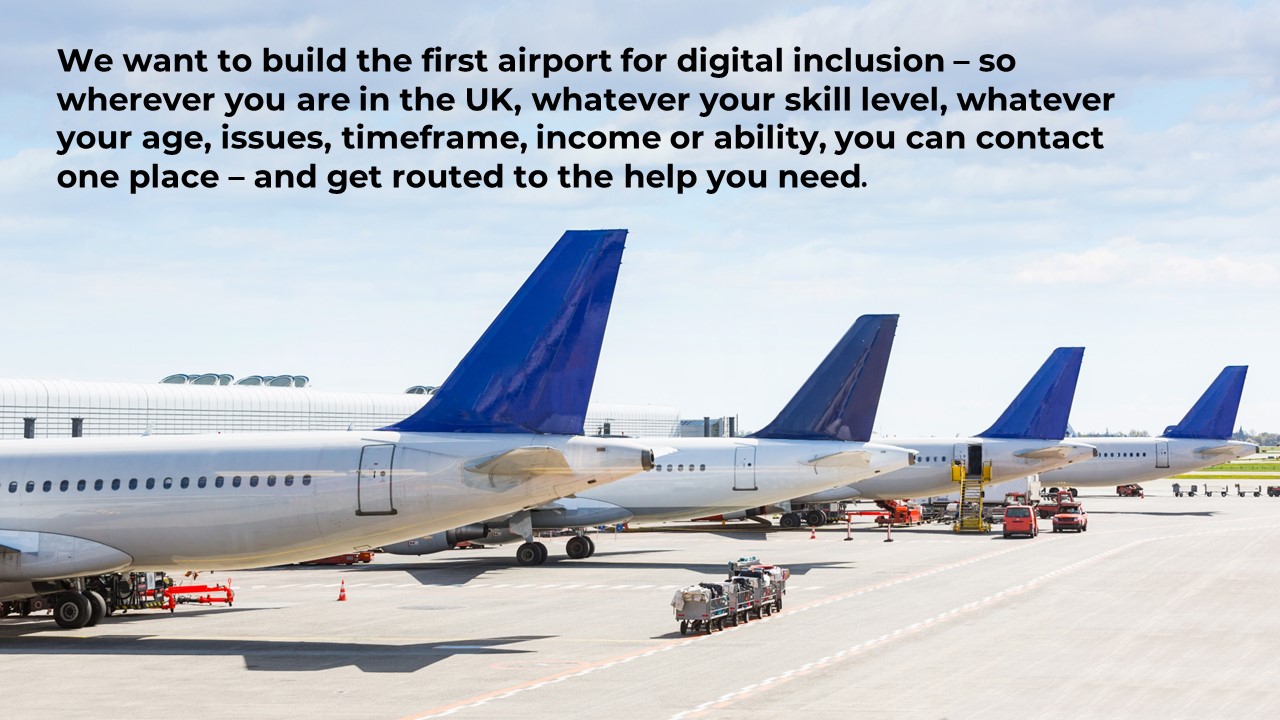
And that’s what we want to build. We want to build the first airport for digital inclusion – that brings everyone and everything together - so wherever you are in the UK, whatever your skill level, age, issues, timeframe, income or ability, you can contact one place – and get routed to the help you need.
We will do this by attempting to bring as many service providers under one roof as we can, and power it by a true transformational tech delivery platform that we are investing in over the next two years, that we think can disrupt the whole sector, and that helps people wherever and however they need support.
Crucially, we aim to not displace the huge ecosystem of providers already out there, but instead offer them a place which knits them all together for the first time, to deliver the work. It really is more the merrier.
We want to build the airport, we don’t want to fly the planes.
But why would it work?
Well, what we think we can do is not only to change people’s lives, but it can save people’s lives too. This is the reason we want to do this – to have a lasting impact.
Part of this model at We Are Digital and something we want to scale is that we go TO the people who need us, we don’t put the onus on them to come to us. And we offer them any channel they want – under one roof.
Take Barry for example:
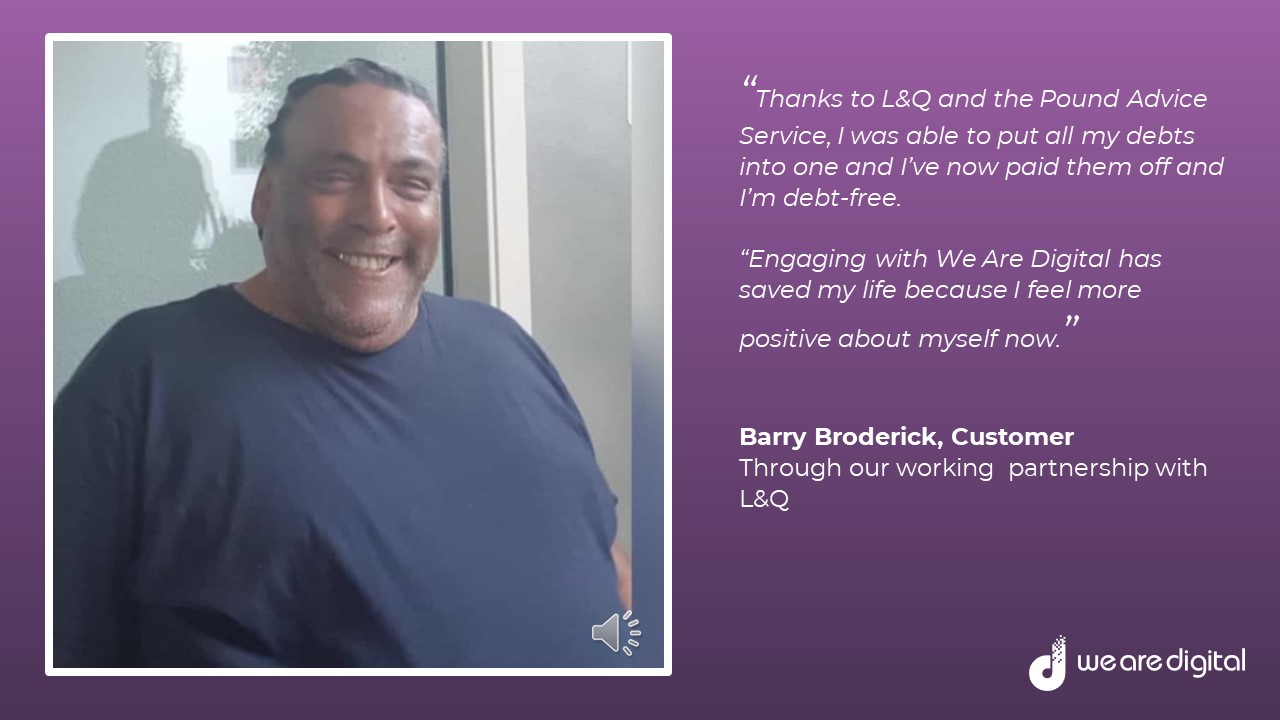
Alongside our digital inclusion programmes, we also run lots of financial inclusion and money advice programmes. It’s like a Venn diagram – to people who lead difficult lives, these issues and exclusions are all related. Barry, on screen, was an L&Q Housing resident in thousands of pounds of debt, and because of this his mental health was suffering, he had a lung condition and had already lost one eye due to a fall. All the while being chased by one of his creditors, who ended up telling him about Pound Advice, a large money advice contract we manage across London for L&Q Housing - through an amazing network of centres, using our airport model.
Now Barry is one of millions that can be helped with the delivery organisations that already exist out there in the UK. But Barry would not have found a solution had he not been offered the service where he was and at his point of need, and connected to that journey through We Are Digital.
According to the Lloyds Bank Digital Consumer Index 2021, almost a fifth of those who reported they had not gone online in the last three months said that “I want to but I don’t know where to get help”, - again, the HOW not the WHAT.
We have got to overcome barriers like this so that we can reach the people who need our help most and never rely on them to have the motivation to come to us. We need to connect the dots for them and tie up services for them.
At WAD, we use a human-centred based model, where we focus on the person, not the solution, backed by behavioural science. But ironically, the solution ultimately to this problem may lie in a clever technology wrapper (the airport platform) to make these programmes work better, that in turn help people to use technology.
But this is just one person I hear you cry! How does this work at scale, or across a whole region?
Our intention, and development of the platform – is to tie in a full end-to-end service across a whole programme – so it will manage everything from the very first referral at the start, through triage, direct booking to a supply chain of partners to support that person, reporting, funding, data and impact at the back-end.
Three years ago, the project Barry used, operated a sporadic contract across 18 providers in London, all using different systems, with no integrations, little technology and people had to wait 5-10 days to be helped due to differing SLAs.
But now, three years on from us taking over the contract, centralising it and testing our new airport model, to bring it all together, the following impact has been seen:
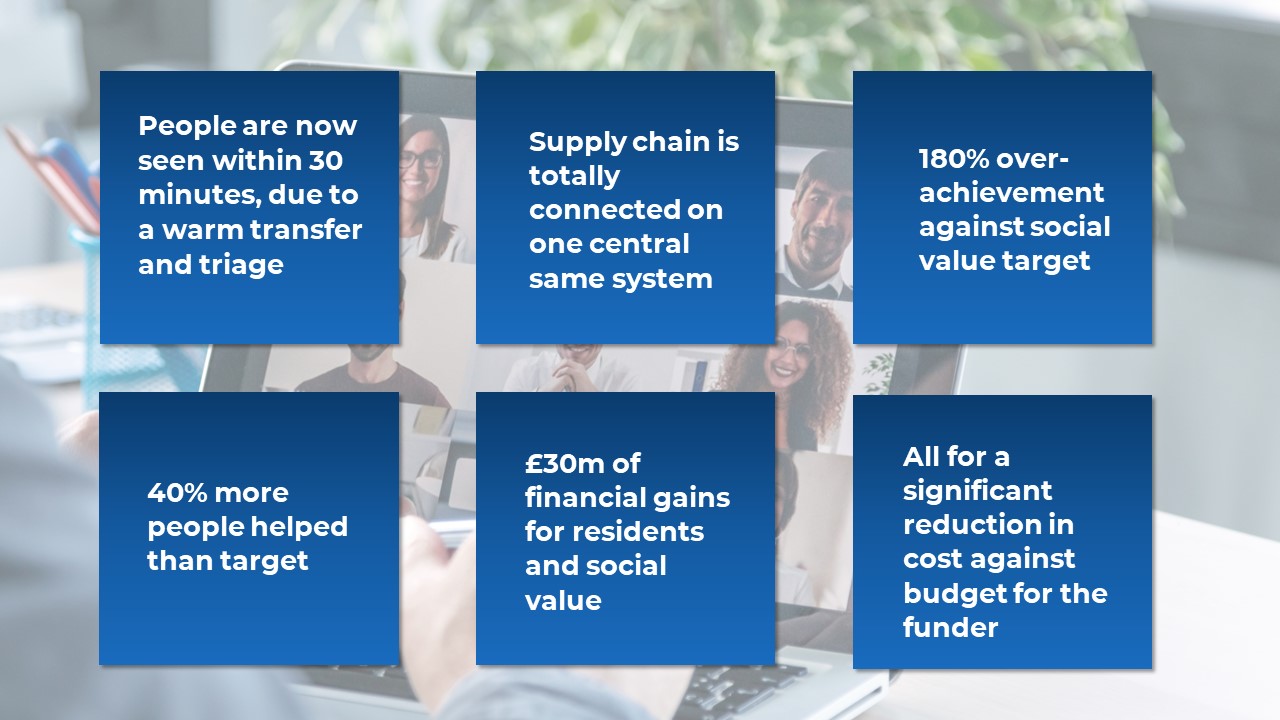
In other words, more people have been helped, more quickly, for less cost, with higher social impact
So we know the model works. And we are seeing this need everywhere. Digital skills is no different. Only recently the head of digital at a large North East council said to me: you know what Matt: we have the people, we have a great person leading the digital inclusion programme, we have the local supply chain, and we do stuff and we deliver stuff. But we have no strategy, no model of delivery, nothing to stick it altogether, overall.
So in conclusion, We need to stop, rethink and relearn, take a human centred approach, utilise the existing delivery organisations out there - and overall just make it far easier for millions of people to get the help they need, through a better delivery model.
Heinz Tomato Ketchup stopped using a glass upright bottle, turned it upside down and enabled people to squeeze the bottle to make it easier.
In the absence of a tight tangible digital inclusion strategy with the latest Government Digital Strategy Report, we now more than ever have to do the same, and we have to put these new models to the government, to the sector, and to you all here today. As one CEO of a large housing association said to me: “it’s hard to stop this replication all over the place. You need something that elevates it”
